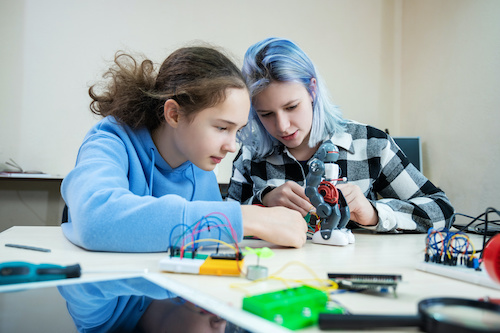Key points:
- Classroom management fosters an environment where students feel encouraged to explore and experiment
- Elementary-level STEM education fosters our future innovators
- STEM programs can’t keep up with AI–let’s focus on Power Skills
- For more news on STEM education, visit eSN’s STEM & STEAM page
Every classroom is a busy place, but STEM-specific classrooms are built on collaboration, communication, and hands-on inquiry. Things are bound to be extra noisy and energetic. This isn’t a bad thing–it’s “the sound of learning,” as a coworker of mine once put it! However, it does mean that STEM classrooms require skilled management to keep students focused on their tasks. So, how do we as educators foster an environment of engagement and creativity without stifling our students’ curiosity?
In my experience, educators looking to create a STEM-centered classroom can take advantage of five teaching hacks which allow them to manage students while still fostering a growth mindset:
Hack 1: Material management
The first challenge in a STEM classroom is material management. To streamline material usage, students should know where materials are located, how to access them, when they can use them, and the appropriate ways to use them. Providing visual aids like stop signs and bin cheat sheets enhances understanding. This creates a clear picture of where and how their learning takes place.
Hack 2: Teach collaboration
Building a collaborative environment is fundamental in STEM education. Effective communication skills are vital for creating an inclusive atmosphere where every voice is heard and valued. This means teaching students not just how to speak, but how to listen as well. When speaking, students should be clear, concise, and prepared to ask deeper questions. When listening, they should avoid interruptions, withhold judgment, and learn to take verbal cues.
Hack 3: Keep it real
Interest-driven learning empowers students to independently question, explore, and solve real-world problems. Consider addressing issues like earthquake safety, oil spill cleanup, or snow removal. These lessons not only impart practical information, but they also show students their education is something that can be applied to the real world–including their homes and communities. Best of all, it’s great for fostering students’ critical thinking, curiosity, and confidence.
Hack 4: Cultivate curiosity
Cultivating curiosity is crucial for student engagement and passion for STEM. Educators can model curiosity by introducing diverse perspectives, offering choice, and asking proactive questions. For instance, you could test them with the viral image of the blue dress to teach them about different perspectives, then ask them to ponder the science behind the image. This hack is great for promoting independent thinking and increases classroom participation!
Hack 5: Nurture growth
If you never fail, you’re not trying new things. Encourage students to embrace failure as a part of the learning process. Show them the positive power of failure by sharing inspiring stories of individuals who learned and persevered from their disappointments (Walt Disney, Thomas Edison, and Oprah Winfrey are just a few!). By empowering students to fail like a champion, we teach them how to set goals and learn from their experiences.
It’s important to remember that classroom management isn’t about maintaining order but creating an environment where students feel encouraged to explore, experiment, and engage with the material. By taking advantage of these five teaching hacks, educators can give students the freedom they need while still providing them with structure and a positive learning environment. Above all, remember to have fun. It’s in STEM classrooms like these that the next generation of great thinkers are grown!
- 4 ways to encourage play in education - April 25, 2024
- CoSN IT Leader Spotlight: Lisa Higgins - April 25, 2024
- It’s time to pay student teachers - April 25, 2024

